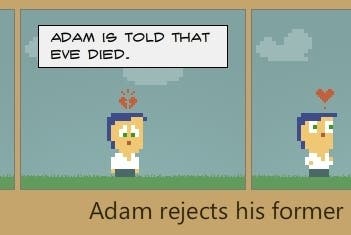Storyteller impressions: All the world's a stage in this IGF-winning puzzler
The butterfly effect.
Video games are often about choice. Do I cure the genophage? Should I save Doug or Carley? Who should I sleep with? Often these choices have unexpected outcomes and it's not until the end that we realise what shoulda/coulda/woulda been. Daniel Benmergui's upcoming experimental puzzle game Storyteller is different though. It allows an entire story to play out in the space of a few comic book-esque panels confined to one screen. It's the player's job to rearrange all of its components to orchestrate the outcome of your choosing.
For example, one challenge I encounter when playing Storyteller at GDC gives me a tombstone and three characters: Adam, Eve and Tim, then asks me to set up a three panel story in which Adam kills himself over Eve. This is easier said than done because each character has certain rules governing their behaviour, such a Eve being a faithful lass, so she won't simply dump Adam for Tim. Instead, a more roundabout solution needs to be executed.

One such solution is to forgo the red-herring namesake and make Tim Eve's lover. Simply place the two of them in the opening panel and little hearts will appear above their heads indicating a romance. Once it's established that these two are an item, all the player needs to do is place Adam and Eve together in the second panel and she'll reject Adam as she's not the sort to cheat on Tim. For the final panel, the player can place Tim and Eve together with a tombstone beside them. Since Adam is the one character not present in the scene, it suggests that the dead person is Adam, who committed suicide due to his unrequited love.
But wait! There's another way this could play out. Adam and Eve could start out as lovers, then the second panel could place Adam and Tim together with the tombstone beside them. Since Eve isn't present (there can be no more than three player-manipulated objects to a panel), it's assumed that she passed on. With only Tim and the grieving Adam left, all the player needs to do is place Tim next to a tombstone in the concluding panel and it's suggested that this is now in reference to Adam, a widower who took his own life.
Of course there are other ways this could play out that don't fulfill the objective, but are amusing nonetheless. Adam and Eve could end up happily ever after while Tim kills himself. Maybe Adam will die and Tim and Eve will hook up. Or maybe Eve will die, but the two guys will just sort of bro out as neither were that attached to her in the first place. Entertainingly, players can always alter the earlier panels and watch as the results change instantly like Biff going back in time with a certain sports almanac.
This should give you a simple idea of how Storyteller works, but the puzzles only get increasingly challenging. Sometimes captions are manipulable and you'll have to swap them around to add context to open-ended images. Other times you'll have five or more panels to work with. And sometimes you'll be tasked with coming up with more efficient solutions that take fewer moves.
Benmergui has been working on Storyteller since 2008 and last year he won the IGF Nuovo Award for innovation. Like SpyParty, this ambitious idea has been in the works for some time and the early screens only reveal its concept art. Benmergui told me he's in talks with an artist to spruce up the visuals prior to release and the final game is expected to launch in early 2014 on PC and Mac with tablet versions to follow.




.png?width=291&height=164&fit=crop&quality=80&format=jpg&auto=webp)




.jpg?width=291&height=164&fit=crop&quality=80&format=jpg&auto=webp)
